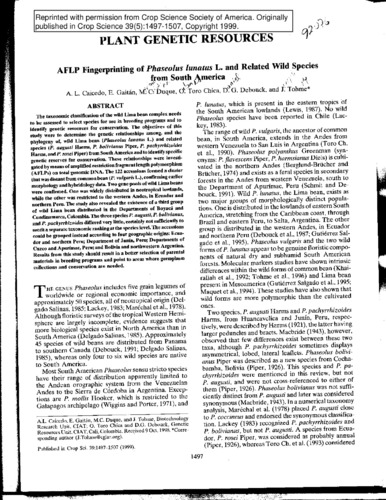AFLP fingerprinting of Phaseolus lunatus L. and related wild species from South America
The taxonomic classification of the wild Lima bean complex needs to be assessed to select species for use in breeding programs and to identify genetic resources for conservation. The objectives of this study were to determine the genetic relationships among, and the phylogeny of, wild Lima bean (Phaseolus lunatus L.) and related species (P. augusti Harms, P. bolivianus Piper, P. pachyrrhizoides Harms, and P. rosei Piper) from South America and to identify specific genetic reserves for conservation. These relationships were investigated by means of amplified restriction fragment length polymorphism (AFLPs) on total genomic DNA. The 122 accessions formed a cluster that was distant from common bean (P. vulgaris L.), confirming earlier morphology and hybridology data. Two gene pools of wild Lima beans were confirmed. One was widely distributed in neotropical lowlands, while the other was restricted to the western Andes, in Ecuador and northern Peru. The study also revealed the existence of a third group of wild Lima bean distributed in the Departments of Boyac a ´ and Cundinamarca, Colombia. The three species P. augusti, P. bolivianus, and P. pachyrrhizoides differed very little, certainly not sufficiently to merit a separate taxonomic ranking at the species level. The accessions could be grouped instead according to four geographic origins: Ecuador and northern Peru; Department of Jun ? ´ n, Peru; Departments of Cuzco and Apur ? ´ mac, Peru; and Bolivia and northwestern Argentina. Results from this study should result in a better selection of parental materials in breeding programs and point to areas where germplasm collections and conservation are needed.

